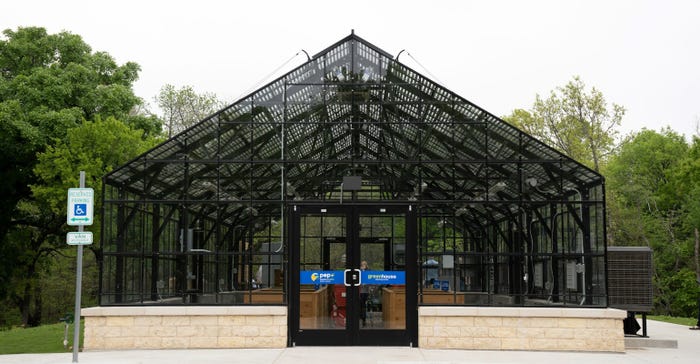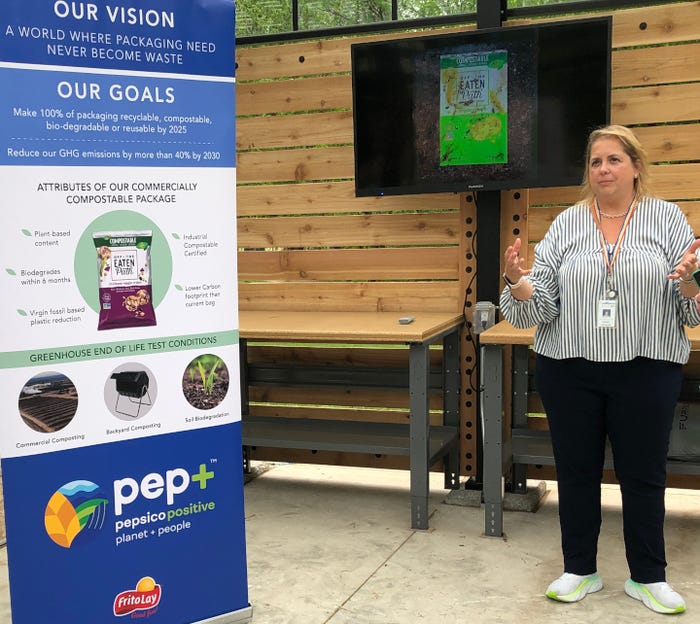PepsiCo revealed a revamped compostable packaging strategy at the opening of a new on-site Greenhouse Learning Center that tests packaging materials for its Frito-Lay and Quaker food divisions.

PepsiCo revealed a new focus on home-compostable packaging at the April 4 official opening of its on-site Greenhouse Learning Center at its Frito-Lay campus in Plano, TX.
We knew this day was coming. Last September, Packaging Digest toured the company’s Packaging R&D Lab to learn more about its commitment to compostable packaging. That commitment is even stronger now that PepsiCo’s Frito-Lay and Quaker food divisions have a working Greenhouse Learning Center to complement the lab “where compostable packaging is born,” according to the press release.
A first for PepsiCo globally, this on-site greenhouse is set up to test packaging for both industrial and home composting scenarios, a critical aspect considering the company’s new attention on home compostability.
Several PepsiCo executives welcomed a local politician and various media outlets to the official opening on April 4, 2023. Denise Lefebvre, Senior Vice President of R&D for PepsiCo (pictured below), cited several reasons for why the company is “super focused on compostability.”

• Compostable packaging is one of the paths that will help PepsiCo reach it’s 2025 goal of designing all packaging to be recyclable, reusable, compostable, or biodegradable. This goal is part of the company’s ambitious sustainability initiative called pep+, which was introduced in 2021.
• Compostable packaging still allows company packaging engineers to develop multilayer films that provide the needed barrier to keep the food fresh and safe to eat (more on this below).
• Lefebvre also sees a lot of flexibility with compostable packaging as an end-of-life option (stay tuned for more on this in an upcoming Packaging Possibilities podcast).
Surprising learnings from the Greenhouse Learning Center opening.
Probably the most eye-opening announcement was that the company’s sights are keyed in on home compostable packaging now (see slideshow for details on why). But I learned a couple other surprising facts during the greenhouse tour and my subsequent private interview with Lefebvre and David Allen, Chief Sustainability Officer for Frito-Lay and Quaker. (Again, we’ll share this interview in an upcoming Packaging Possibilities podcast).
Regarding compostability of Off The Eaten Path bags, Sri Narayan-Sarathy, Director, Global Foods Packaging, PepsiCo, tells me, “The metallization layer is not a problem at all.” The metallization layer — which is vacuum deposited and is needed to provide moisture, oxygen, and light barrier — does not interfere with the package’s compostability. Previously, a foil layer would render the entire package non-degradable. However, Lefebvre confirms that the structure for the company’s Off The Eaten Path bags is certified compostable to ASTM 6400 standards by the Biodegradable Products Institute (BPI). That structure is (inside to outside) polyhydroxy alkanoates (PHA)-based resin/print/adhesive/metallized layer/primer coating/PHA-based resin/PHA-based resin/amorphous PHA-based resin.
Narayan-Sarathy also offers that the shelf life of their compostable packaging, as it relates specifically to moisture, is “challenging.” But she adds, the bag they have now is “almost on par” with the structure of the company’s traditional snack packaging.
I knew the environments for industrial and home composting were different, and that’s why packaging degrades differently in each case. But I learned that the condition for home composting is considered “cold” and for an industrial situation is “hot.” That’s why controlling the temperatures and moisture content of the composting environment is critical (see the environmental controls in the slideshow).
But, a surprise to me, is that composting doesn’t happen in soil; it happens with organic materials, like the straw, alfalfa hay, and pellets being used at this greenhouse to simulate an industrial compost. The resulting “compost” product then combines with soil to add its nutrients.
The most surprising piece of information I learned was that composting generates CO2, a gas we know contributes to global warming. Hmm. I thought CO2 was bad. So why is composting good if it generates a bad gas?
According to the journal BioCycle, “As organic material decomposes or transforms in a compost pile, the primary gas given off is CO2. This is not considered to have an effect on global warming, as the plant matter and other feedstocks that are decomposing are from what is called the short-term carbon cycle.”
The CO2 generated through composting is released back into the earth, not the atmosphere, and used for further natural cycles (through sequestration).
From a technology point of view … even with this new greenhouse, packaging material testing will take time. When asked about using simulations (powered by artificial intelligence or A-I, too), to help speed up the learnings, one of the executives admitted that Frito-Lay is developing this capability now.
PepsiCo sees financial and environmental green in compostable packaging’s future.
PepsiCo has been sharing with the industry at large, and will continue to do so, what it learns about compostable packaging through field tests at the greenhouse. This will help advance the potential of compostable packaging as a viable end-of-life option for retail food products.
Several executives in attendance praised the company’s “ongoing commitment” to compostable packaging. From what I’ve seen, the financial investment is substantial. However, the payoff could not only handsomely benefit PepsiCo, it might make a real positive difference in the world. And it could serve as a catalyst for many other retail food companies to follow its lead in compostable packaging.
Is this the beginning of the tipping point for a much wider use of compostable packaging in the US?
About the Author(s)
You May Also Like




